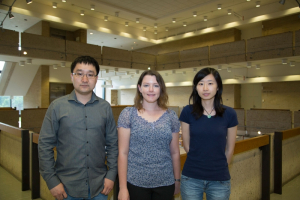Three Cullen College Ph.D. students received poster awards at the 2015 Southwest Catalysis Society’s spring symposium held at the University of Houston on April 24.
The Southwest Catalysis Society (SWCS) is a branch of the North American Catalysis Society, a group focused on promoting and encouraging the growth and development of the science of catalysis. Out of over 25 posters submitted for the SWCS spring symposium poster contest, only five were chosen by judges to receive awards.
The UH winners include chemical and biomolecular engineering students Rui Li, Yuying Song and Melanie Hazlett. Each student received $100 with their poster award.
Li works closely with advisor Jeff Rimer, Ernest J. and Barbara M. Henley Assistant Professor of chemical and biomolecular engineering, to rationally design zeolite crystals in order to improve their catalytic activity, selectivity and stability.
Zeolites are used as adsorbents and catalysts in a variety of chemical processes, spanning applications from gasoline production to additives for laundry detergent – not to mention thousands of other commercial and consumer products. But despite the ubiquity of these crystalline materials, the ways in which zeolites are grown are surprisingly not well understood.
Li’s research focuses on one-dimensional zeolites, which are often used as catalysts for petrochemical reactions. However, one-dimensional zeolites suffer from instability and diffusion limitations. Li, then, is working to engineer one-dimensional crystals that perform more effectively as catalysts.
Working in Rimer’s lab, Li and his research group discovered that adding organic molecules called zeolite growth modifiers, or ZGMs, to specific locations on the crystal can hinder growth in that direction while redirecting growth in another direction. “It’s a novel method, and we need to understand more about this mechanism and know more about what’s happening at the molecular level of binding these molecules to the crystal surface,” Li said.
Li’s award-winning poster based on this research was titled “Rational design of one-dimensional zeolites: Pathways to control crystal growth.”
After earning his doctoral degree, Li said he hopes to continue performing cutting-edge research in a full-time position in industry. Working side-by-side with Rimer, one of the leading experts in the field of zeolite growth, helped him to hone his research skills in preparation for life after college, Li said.
“Dr. Rimer was very supportive,” he said. “I learned a lot from him.”
Song and Hazlett use their complimentary computational and experimental research methods to develop new catalysts that reduce harmful emissions from advanced low temperature combustion engines. Both participate in a team project supported by the National Science Foundation (NSF) and the U.S. Department of Energy (DOE) and led by associate professor of chemical and biomolecular engineering Bill Epling.
Low temperature combustion engines have increased fuel efficiency and have shown promise in reducing the overall amount of pollutants emitted in diesel engine exhaust. However, the lower temperature of combustion means there isn’t enough heat to burn off, or oxidize, the remaining unburned hydrocarbons, carbon monoxide (CO) and nitrogen oxide (NO) in the engine’s exhaust.
The U.S. DOE has set a challenge for researchers to develop emission control technologies that perform at temperatures of 150ºC or lower to enable fuel-efficient engines with low exhaust temperatures to meet EPA emission standards. The UH team contributes to this challenge by developing improved diesel oxidation catalysts with new architectures and compositions that minimize the use of costly precious metals while effectively lowering emissions.
Song works with advisor Lars Grabow, assistant professor of chemical and biomolecular engineering and chemistry, using computer modeling to identify catalysts that would work well in reducing harmful engine emissions. By running computer simulations, Song identifies new materials that can potentially be used as catalysts to remove CO and NO from the engine’s exhaust at much lower temperatures.
Song’s poster was titled “Activity trends for CO and NO co-oxidation catalysts at low temperature diesel emission conditions.” For Song, the SWCS spring symposium was the first time she submitted her research for a poster contest. “I was extremely excited to get an award,” she said. “I was so nervous to be there since it was my first poster contest. I feel lucky to have won an award.” Song said she was inspired by her current research to try to land a research position in industry.
Hazlett, who is advised by associate professor of chemical and biomolecular engineering Bill Epling, picks up the research where Song leaves it off. Once Song has identified potential catalysts for oxidizing CO and NO at low temperatures, Hazlett takes to Epling’s lab to create the alloys and test them through careful experimentation.
Furthermore, Hazlett studies how active site distributions in catalytic reactors affect overall performance, which was the basis of the research presented in the poster titled “The axial reaction profiles in diesel oxidation catalysts under simulated low temperature combustion exhaust.”
Using a combination of novel in-situ reaction measurement and surface characterization tools, her research is demonstrating that tailor-designing the catalyst composition along a reactor length can reduce catalyst cost and improve performance, both critical with increasing emissions regulations and fuel economy standards.
Working with Epling, she said, was one of the highlights of her research at UH. “He is a very supportive advisor,” Hazlett said. “Dr. Epling is a really great guy.”
Hazlett hopes to enter the world of academia as an engineering professor after she earns her doctoral degree from UH.
